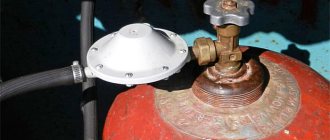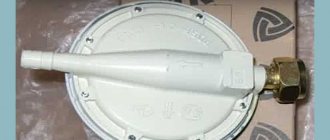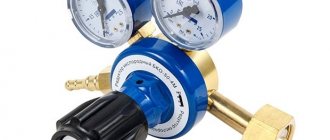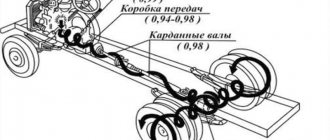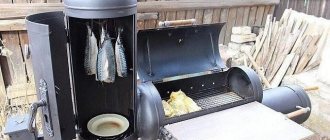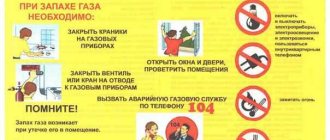As is known, liquefied hydrocarbon gas (propane-butane) is stored in cylinders or gas tanks under a pressure of several bar. To reach the operating parameters of consumers (30-50 mbar), a special device is used in autonomous gas supply systems for private facilities - a household propane reducer . If we draw an analogy with an electrical network, this device acts as a stabilizer, that is, it reduces the pressure to the required value and automatically maintains it at the same level.
Design and principle of operation of the gas reducer.
Any propane reducer contains the following components:
- valve;
- working chamber;
- locking spring;
- compression spring;
- membrane
The throughput of this device depends on the degree of opening of the valve, which is influenced on one side by a membrane and a pressure spring, and on the other by gas and a shut-off spring. The higher the propane pressure in the cylinder and the lower the flow rate of gas-using equipment, the closer the valve is located to the seat. Conversely, as the pressure in the chamber drops and the flow rate increases, the valve opens more. The operating parameters of a household propane reducer are determined by the stiffness of the springs and the elasticity of the membrane. Some models are additionally equipped with a valve, the shaft of which is connected to a pressure spring, which allows you to manually regulate the gas supply within a certain range.
Operating principle of the device:
Modern propane reducers are sometimes additionally equipped with a safety mechanism that is triggered if the inlet pressure of propane-butane is exceeded. In order to increase the level of safety, such reducers are usually installed on gas tanks and group cylinder installations used for gasification of one or several houses. You can learn more about how autonomous heating is implemented in private households from the article: Autonomous heating with propane butane.
Features of the operation of composite gas cylinders
This is a new generation of gas tanks. Composite cylinders differ from their predecessors in their lighter weight (such a cylinder is more than twice as light as a traditional one) and greater safety.
In the event of an explosion of such a container, no fragments will form. Another plus is the impossibility of corrosion forming inside the cylinder. Devices used in conjunction with a composite cylinder are subject to increased requirements.
- A reducer for a composite cylinder is used to maintain constant outlet pressure. For new types of tanks, gearboxes are used that comply with European standards according to the EN 12864 standard.
For example, this could be the A300i-A310i device. It differs from the old RDSG 1-1.2:
- the presence of a nut that can be tightened without much effort (KLF connector);
- long service life of the valve gasket (at least 10 years).
Other design features include a spout recessed into the valve outlet and a circular collar that fits into the valve seal. These qualities provide additional sealing of the connection.
- Regulator for composite tank. It should not be confused with a gearbox! The regulator only maintains a given level of gas flow in liters per minute. This device can be universal or made for a specific model of composite cylinder. It is best if you have both the regulator and the cylinder from the same manufacturer.
How to choose a household propane reducer
The choice of a device for supplying a propane-butane mixture to gas-using equipment is based on two key parameters:
Sample passport for a gas stove
The operating mode of most household propane appliances is 30 mbar, 37 mbar or 50 mbar. Based on this indicator, the appropriate gearbox is selected. If its output pressure differs from the operating parameter of a gas stove, boiler or, for example, a grill, this may lead to improper operation of the equipment and even create an explosive situation.
The characteristics of the propane reducer can be seen on it - 3 kg/h and 29mbar
30 mbar, 1.5 kg/h (kg/h)
For stable and safe operation of the gas consumer, it is also important that its consumption does not exceed the performance of the gas reducer. In this case, the upper level of gearbox consumption is not standardized. That is, for a boiler with a power of 24 kW with a mass flow of 2 - 2.5 kg/h, it is permissible to install a gearbox with a capacity of 3 kg/h and higher - the automatic boiler or stove will still not allow “extra” gas to pass through.
0.45 m3 (for propane - butane)
1000 Pa - 1 kPa - 10 mbar
30 mbar - 0.03 bar
Some owners of autonomous gas supply systems make the mistake of purchasing industrial gearboxes instead of household ones, considering them more reliable. Firstly, such devices are an order of magnitude more expensive, and secondly, they are designed to work with more powerful gas equipment, so they are not always compatible with household appliances.
You should also pay attention to the type of thread of the device. Gearboxes designed to work with non-flammable gases are equipped with a right-hand thread, and with flammable gases they have a left-hand thread and a mark on the nut.
Rules for installation and operation of a gas reducer
To connect a propane reducer to gas-using equipment, two methods are used: using a herringbone fitting or using a threaded connection. The first option is considered the simplest and is often used to connect the cylinder to a gas stove. The second method is more reliable and aesthetic, in addition, it allows you to connect one propane tank to several consumers at once.
Connection via fitting
Whatever option is chosen, during the process of connecting the gas reducer and starting the system, you must adhere to the following instructions:
- Make sure there are no cracks or depressions on the housing, check the integrity of the pressure gauge (if equipped).
- Connect the device to the cylinder (gas holder). For better tightness of the threaded connection, you should additionally use flax or FUM tape.
- Connect the gas line to the outlet pipe of the reducer. When using a herringbone fitting, secure the pipe at the mounting location with a clamp.
- Slowly open the cylinder valve, then turn the tap on the gas consumer.
It is worth noting that the device is intended for use in temperate climates, so its use is permissible at temperatures from -15 to 45 degrees Celsius.
Choosing a household reducer for a gas cylinder
A reducer for a household gas cylinder performs a function comparable to that of a stabilizer in the operation of an electrical system; this device is a stabilizer, but for gas equipment. Its main goal is to reduce the gas pressure coming from a gas pipe or from a gas cylinder to the required value of the equipment to which the blue fuel is supplied.
The next most important function of the gearbox is to automatically maintain the operating pressure at the proper level. Reducers for gas cylinders differ in shape, size, weight capacity, etc. But according to the principle of operation, these devices can be divided into only two types: direct and reverse gearboxes.
The principle of operation of a gas reducer for a cylinder
Direct type gearboxes are designed in such a way that the gas passing through the fitting opens the valve and presses it to the seat using a spring, and high-pressure gas stops entering the chamber. Next, the membrane pushes the valve away from the seat, the pressure gradually decreases, reaching the operating pressure level of the gas appliance to which the reducer is connected.
As a result, the spring straightens, the valve moves away from the seat and ceases to prevent the flow of new volumes of gas fuel. If the pressure begins to increase again, then this spring is again pressed down by the valve and gas does not enter the device.
In reverse-action gearboxes, when gas enters, the valve compresses and prevents it from entering the device. With the help of a special adjusting screw, the pressure spring begins to compress, the membrane bends, the transfer disk presses the return spring, the valve rises, and the gas again moves into the chamber of the device.
Gas reducer "frog" for a cylinder
Features of using gas reducers in everyday life
We know that gases are divided into flammable and non-flammable. At the same time, I would like to remind you that gearboxes for different types of gases do not differ in appearance from each other, and in order to distinguish them, it was customary in the manufacture of devices to make threads for gases with flammable properties - “left”, and for non-flammable gases - “right” .
Gearboxes operating on various types of gas are used in a variety of areas of industry, agriculture, construction, and medicine. For example, oxygen reducers are used in gas welding, cutting, and in the work of medical institutions, and acetylene reducers are used in body work at car service and repair stations.
Propane reducers are used in construction, especially in roofing work, but the main purpose of such reducers is to supply and regulate gas from gas cylinders to gas stoves.
More recently, outdated gas containers have been replaced by new, so-called composite cylinders, which differ from their predecessors in lighter weight and a higher level of safety. New technologies have advanced so much that even if, God forbid, of course, something happens to such a cylinder, then when it explodes you will not even find fragments.
Composite gas cylinders
These gearboxes include the A300i-A310i gearbox, which differ from the gearboxes we are used to in the following characteristics:
— the presence of an easily tightened nut; — increased gasket service life to 10 years; - a type of construction that ensures more reliable tightness of connections.
Household reducers for gas cylinders most often have a very affordable price, and considering the role these devices play in ensuring the safety of not only our homes, but sometimes our lives, their cost can be called absolutely acceptable.
When choosing a reducer, it is necessary to take into account all the details: what gas the device will be intended for, what type of gas cylinder will be used, what diameter of the gas hose is needed, etc. For example, it is recommended to purchase a reducer from the same manufacturer as the device itself to which gas is supplied.
Types of gas reducers for gas cylinders and prices
Let's look at some types of regulators for gas cylinders, which are in good demand in the gas equipment market.
Types of gas reducers by area of use
In general, all automatic pressure control devices are divided into reducers for flammable gases (methane, hydrogen, etc.) and inert gases (helium, argon, nitrogen, etc.).
To avoid confusion, the first ones have a left-hand thread for connecting the gearbox. The second ones have a right-hand thread (including the oxygen device).
- Acetylene gearboxes. Used in enterprises for gas welding, cutting pipelines; as well as in car repair shops when repairing car bodies.
- Oxygen. Used for cutting, gas welding and soldering. Also used for organizing scuba diving and in medical institutions.
- Airborne. Reduce air pressure in air communications and networks. Used by submariners.
- Propane. They are used for soldering, cutting, and heating work in various types of enterprises. Also necessary in construction (for example, when installing a bitumen roof) and in everyday life to maintain the required pressure in gas stoves.
Heating a country house with bottled gas: what is needed and how to install it
In order to determine how feasible it is to heat a country house with liquefied gas from cylinders, you need to find out what is needed for this (what equipment, fixtures, pipes), how to install it all and, finally: how much will it cost? Because the cost of heating is very often one of the main criteria when choosing its type.
Rice. 1 Scheme for heating a house with bottled gas
Necessary equipment
To install home heating using gas cylinders, you need: a gas boiler, a burner for liquefied gas, gas cylinders, reducers, shut-off valves and a gas pipeline through which all this will be connected into one system.
In order to be able to heat a house with bottled liquefied gas, the first thing you need is a gas boiler. What kind of boiler is suitable for this? Yes, almost any of those that are intended for main gas.
To heat a country or country house with gas cylinders, you can use gas boilers, both single-circuit and double-circuit (heating + hot water supply) of different capacities, in floor-mounted or wall-mounted versions, with an open or closed combustion chamber.
The vast majority of them can also be adapted for liquefied bottled gas; you just need to change the burner, which sometimes comes with the boiler. If not, then you can buy such a burner.
When choosing a gas boiler, you should give preference to a model with a minimum operating pressure: the lower, the better in this case. This will allow you to make maximum use of the gas from the cylinder.
In addition, an important characteristic of a boiler for heating a private house with gas cylinders is its efficiency. It is advisable to choose a boiler with maximum efficiency (90-95%). This indicator when the boiler operates on liquefied gas is more important than when it operates from the mains, since it significantly affects the cost, and therefore the feasibility of this type of heating.
In addition to the boiler, a gas convector heater can be used to heat one or two rooms, which does not require the installation of a system of pipes and radiators.
System installation
When installing a home heating system using gas cylinders, you can connect one or more gas cylinders to the gas boiler at the same time. The second option is more preferable, since it allows you to increase the operating time of the installation between replacing cylinders. It is best to combine cylinders into a group with a number of 3 to 10 pieces.
